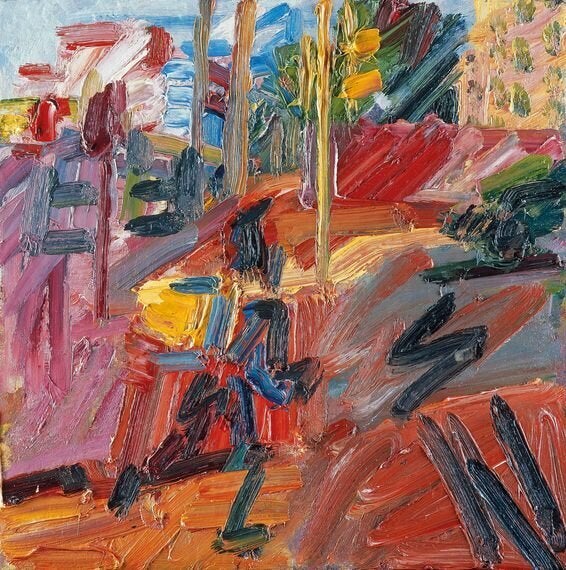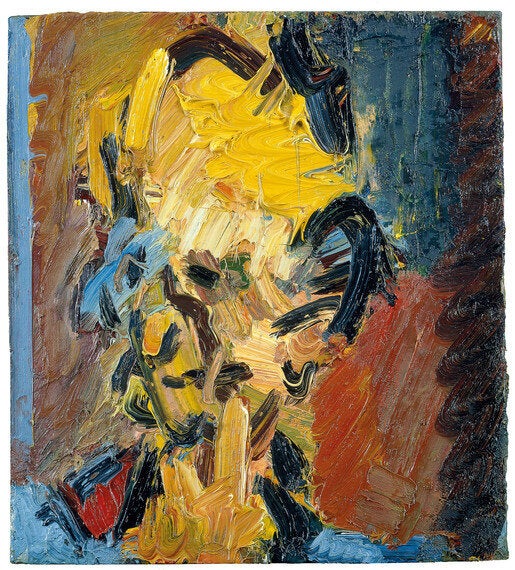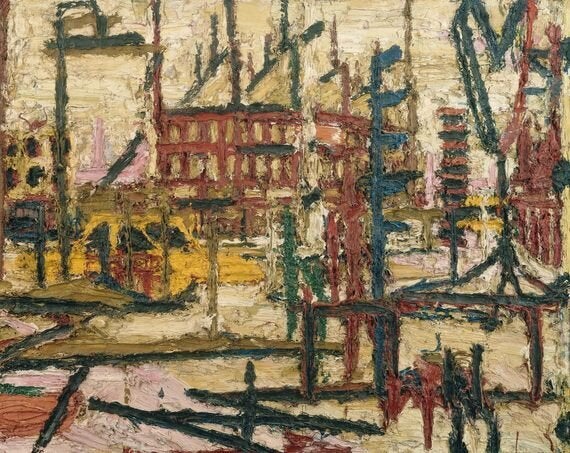
Not every art show overwhelms you. Certainly not every artist has the ability to capture intense, strong emotions on a canvas, let alone harness them in a way that grabs the viewer. But Frank Auerbach is different. And this show of Frank's work at the Tate Britain is different, for what it displays is not just an artist of profound talent and ability, but also one of immense emotional intensity and depth.
What first hits you about Frank's paintings is the texture. These are canvases thick with oils. Layers of paint built up and scraped down, the artist always editing and correcting himself, painting over what he saw a moment ago with what he sees now. And doing this hundreds of times.
This is particularly true in the first few rooms - the exhibition is hung in broadly chronological order - where Frank's earlier works are canvases almost two inches thick with oils that have been scraped aside, built up and painted over.
Canvases were too expensive to go to waste back then but in addition to the hazy blurred figures and landscapes created, this dense build-up of oils betrays Frank's own battles to channel how he feels about the world around him, about the figures and places in front of him, and to convey them in all their complexity.

The results are paintings so thick with oils that they are almost three-dimensional, the forms rising out from the canvas. And the forms themselves, such as in E.O.W. Nude, 1953-4, are blurred, their skin cracked from the layers of old paint, their outline unclear yet oddly sharpened by reducing form to colour.
Then what hits you next is the emotional depth. These are profound, emotionally charged pieces of work. There is a darkness in Frank's paintings of people that reveals as much about the artist as they do about the sitter.
It doesn't seem appropriate to call these works 'portraits' for these are more psychological interrogations rather than reflections of people's external appearance. These are examinations of the human condition, of our shadows and thoughts.
The oils are worked so heavily that much is obscured, facial features blurred and undefined. Whether it's Head of E.O.W II from 1961 or Head of William Feaver in 2003, the intensity, the fevered reworking of the pieces, is practically tangible across the body of his work.
And even when he uses uplifting or mellow colours, there's still an eeriness, such as in Head of E.O.W II where the warm yellow tones of the skin are cut through by the fiercest set of beady red eyes you've seen. Or in E.O.W. Half-Length Nude, 1963, where the sitter's soft skin tones are contrasted with the shadow of red that falls across her face.

I was completely hooked by the series of paintings of favoured model, Juliet Yardley Mills seated in his studio. And again here, the vivid yellows of the face and torso are hemmed in by darkness, by thick black outlines to her frame, her features carved in using thick black paint. And like so many, the sitter is introspective, her gaze looking away into the distance, her attention not on us but elsewhere.
Frank can turn away from these brighter hues and, when he does, the intensity is unrestrained. The stunning and haunting Head of J.Y.M II, 1984-5, is a case in point. A deathly pale face and neck cranes back from us, desperately avoiding our gaze and attention. The sombre palette of greys and blacks only heightening the sense of someone desperately lost to the tumult of their own mind.
Or should that be the artist's weaving in how he feels, as well as the sitter? Who knows? But what you sense from these portraits is, unequivocally, life - for both artist and sitter. There is blood in these people's veins. Passions and fears, hopes and dreams.
So the contrast with the energy in Frank's landscapes and urban settings is not just marked, but extraordinary.

Frank has spent most of his life living and working in North London and he has repeatedly returned to the area around him - to Mornington Crescent, to Primrose Hill - and his works offer fascinating insight into how these places have developed and transformed over the past 50 years.
These canvases brim with energy, with motion. Rapid broad brush strokes in reds, pinks and oranges, the blurring of traffic and people as they almost pass through the painting. It's like a snapshot of frenetic energy, life with the pedal to the floor, everything in a rush.
Yet there is rigid structure too. Slick, bold, straight lines define the buildings, the pavement, even the lampposts. There is architecture and order to these compositions. Order containing (just about) the chaos that happens within.
Sometimes I do understand when people come out from art galleries and say, 'you know it's fine but I didn't really get it' or 'it's fine but I'm not really moved'. It happens, I get that. And contemporary art especially can seem emotionally inaccessible for many. But I swear you won't feel that with this extraordinary Frank Auerbach retrospective. It's brings both an emotional rush and intense emotional reflection. A unique exhibition on a unique artist.
Tate Britain, London to March 13, 2016
Image Credits:
1. Hampstead Road, High Summer 2010, Painting, Oil paint on board 562 x 562 mm, Private collection © Frank Auerbach, courtesy Marlborough Fine Art
2. Head of J.Y.M II 1984-85, Private collection © Frank Auerbach
3. Head of William Feaver, 2003, Oil on board 451 x 406 mm, Collection of Gina and Stuart Peterson © Frank Auerbach, courtesy Marlborough Fine Art
4. Mornington Crescent 1965, Painting, Oil paint on board 1016 x 1270 mm, Private collection © Frank Auerbach, courtesy Marlborough Fine Art